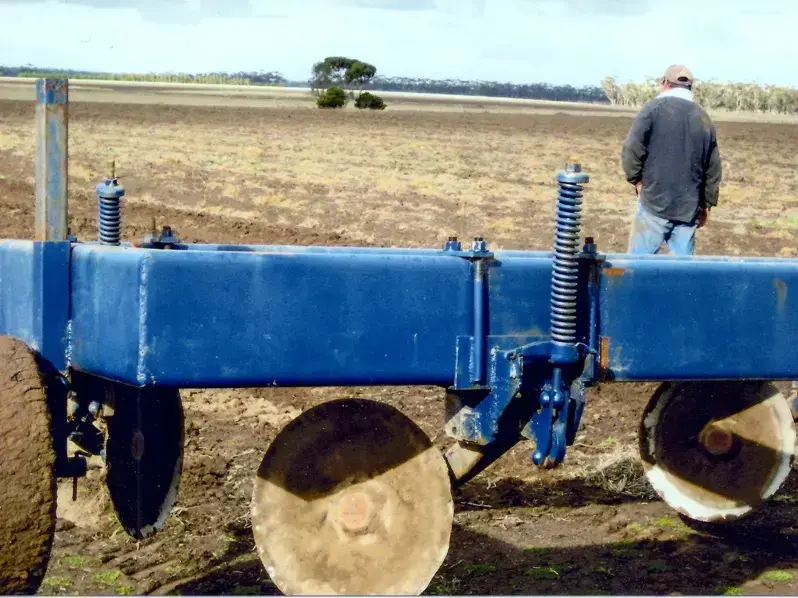‘Briandra‘
A REGENERATIVE AGRICULTURE CASE STUDY FROM VICTORIA
 Upon learning the links between soil health and waterlogging, Brian and Sandra Wilson concentrated on improving their soils, adopting a technique to improve drainage and biologically managing stubble.
Upon learning the links between soil health and waterlogging, Brian and Sandra Wilson concentrated on improving their soils, adopting a technique to improve drainage and biologically managing stubble.
 Upon learning the links between soil health and waterlogging, Brian and Sandra Wilson concentrated on improving their soils, adopting a technique to improve drainage and biologically managing stubble.
Upon learning the links between soil health and waterlogging, Brian and Sandra Wilson concentrated on improving their soils, adopting a technique to improve drainage and biologically managing stubble.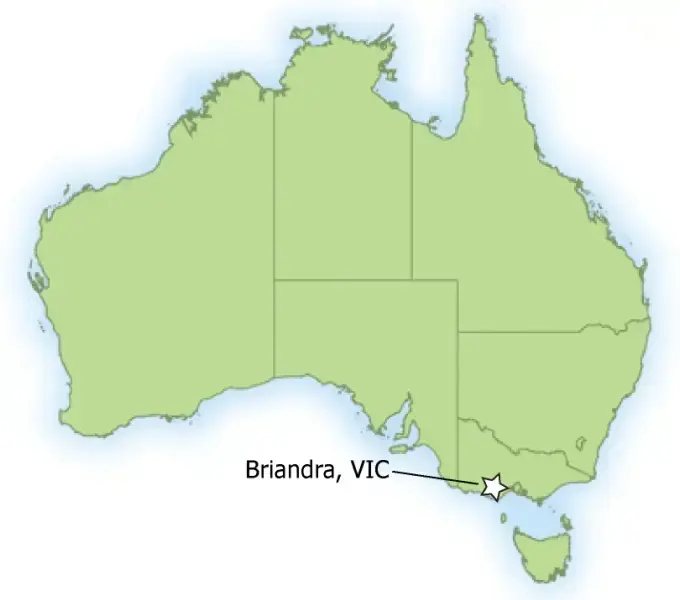
Mingay, 16km north of Lismore, 170km west of Melbourne, VIC Western Plains
FARM FACTS
ENTERPRISE: Crops. Sheep. Cereal, oilseed and pulse crops; Merino sheep grazing
PROPERTY SIZE: 1073 hectares, 700 cropped
AVERAGE ANNUAL RAINFALL: 650 mm
ELEVATION: 20 m
MOTIVATION FOR CHANGE: Needing to diversify to maintain production and address waterlogged soils
INNOVATIONS
- Raising crop beds
- Using brewed cellulose-digesting bacteria and fungi combined with grazing to manage cereal stubbles
- Spreading biological blend on soils
- Innovations commenced: Raised beds 1993/Biological blend 2002
KEY RESULTS
- Increased the area available for cropping through improved drainage
- Adoption of practices across a community
- Improved soil health and fertility
- Increased sheep weight gain
Introduction
By creating raised narrow beds of soil Brian and Sandra Wilson achieved major improvements in drainage and the structure of their soil. This led to more reliable crop yields and the production of considerable amounts of stubble.
A stubble digestion program was initiated to manage cereal stubbles, using brewed cellulose-digesting bacteria and fungi combined with grazing. The wheat stubble is now incorporated into the soil and is used to renovate the beds.
A biological blend, a mixture of brewed microbes, humates, basalt, soft rock phosphate and various trace elements, was spread to rectify soil deficiencies.
As a result of the various techniques applied, the changes to the soil both physically and chemically are remarkable, transforming from hard setting grey clay to a red/brown non-sticky loam. The ratio of calcium to magnesium moved towards a desirable 5:1, improving the availability of phosphorus, potassium, sulphur and other nutrients. This compared to conventional practices of applying up to eight tonnes per hectare of lime, and correcting pH to around 6, which had not improved calcium levels.
Background
Briandra
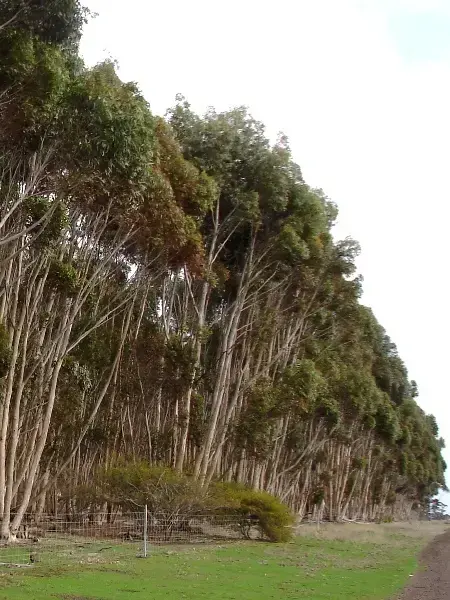
Sugar gum shelterbelt originally sown in the late 19th century.
Briandra was originally part of the ‘Gala’ estate, which was settled by a scot named John Brown, probably in the early 1840s. This estate was broken into smaller properties later in the 19th century and the government acquired part for soldier settlement blocks in 1919 1
The policy to subdivide large pastoral properties into soldier settlement blocks assumed that smaller-scale farming would be viable 2. This was often not the case on Western Victoria’s basalt plain. Although rainfall is generally reliable, poor drainage caused by the heavy clay soil was a problem during the winter months.
The climate in the region is temperate and average yearly rainfall is around 650mm. The local topography is flat to undulating, with some deeply incised drainage lines where streams have cut through the basalt plain to underlying sedimentary strata. A watercourse, Brown’s Water Holes, runs from north to south through Briandra, continues to the town of Lismore and terminates in Lake Gnarpurt, one of the western district of Victoria’s saline lakes. Soils are typically heavy, deep hard-setting clay that has developed on basalt.
Sugar gum (Eucalyptus cladocalyx) shelterbelts run along several road and paddock boundaries. The shelterbelts are about 50 metres wide and occupy a total area of about 10 hectares. They were originally established in the late 19th century because there was little tree cover or timber available.
The people from whom Brian and Sandra bought the property had held it since 1912. When they were first in the area, the Brown’s Water Holes watercourse was a flood plain through the tussocks, which could be crossed by horse and cart anywhere along its length.
During the 1950s, most of the native pasture was replaced with phalaris and sub clover. The former owners felt that these grasses were becoming too invasive on the higher fertility soil, and they had ceased using any phosphorus fertilisers some fourteen years before. As a consequence, the pastures were very phalaris dominant, and together with their conservative stocking rate, were also very rank. Cropping was only performed in a limited area, mainly oats for sheep feed and wheat, and was not very successful due to high prevalence of waterlogging. The flock was mainly Corriedale, which was common in the district at the time.
The Wilson family, Brian, Sandra and four children, moved to Mingay from South Australia in 1985. The children have since left the farm and Brian and Sandra run the farm with the help of an employee, who lives on an adjoining smaller property. About 700 hectares of the property are cropped and 330 hectares is permanent pasture.
Changing Practices
WATERLOGGED
We realised that if we were to survive we had to diversify our production so that we would be less subjected to the vagaries of the market.
By the time the Wilson family moved to Briandra, the wool industry had been in decline for many years. The creek had eroded to a depth of up to three metres in places and bridges were needed to cross it.
“Pasture pugging and waterlogging gave us little confidence of achieving good outcomes in crops and pasture growth”, Brian recalls. “We had come from a merino sheep and mixed cropping operation, in 432mm rainfall and sandy soils. It was quite a learning experience to manage waterlogged soils.”
In 1987, after a few wet years, the Wilsons ceased cropping and fully dedicated themselves to wool growing. Failed crops and high wool prices made this a good decision, until the collapse of the wool reserve price scheme.
“We realised that if we were to survive we had to diversify our production so that we would be less subjected to the vagaries of the market.”
“We realised that we did not know how the basalt plains functioned as an ecosystem and why it was in such poor condition. We lacked detailed technical information. It was not until we went and talked to a wide range of experts that we began to understand why the soil condition and the waterlogging problems were related.”
Brian and Sandra commenced their journey to improve the soil health and fertility over the long term. They sought expert advice, paid for a digital elevation model and collected soil samples and had them analysed and explained. They realised that they would have to restore soil health to address the waterlogging before they could produce productive crops. To achieve these goals Brian and Sandra decided that they would have to do things differently from their neighbours and the way the land had been managed previously.
Raising the beds
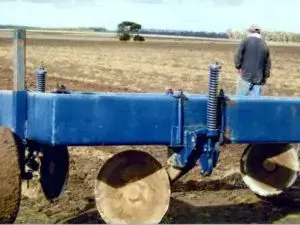
Raised crop bed former
In November 1990 Brian and Sandra installed 40 hectares of sub surface drainage in an endeavour to prevent waterlogging, and to see if they could successfully grow crops. They found that they could produce high yielding autumn/winter sown crops without the constraint of waterlogging. This doubled the potential yield of spring sown crops and was much more reliable.
Brian recalls, “The 1992 wheat crop was planted early May, some of it to the experimental red winter wheat ‘Lawson’. In a very high rainfall spring and summer, this crop survived, and though weather damaged, yielded well with the Lawson giving seven tonnes a hectare. Satisfied that with drainage crops could be grown successfully, we installed a further 40 hectares of underground drains in 1995.” However with the cost of establishing the drains over $1000 a hectare, this was prohibitive, and the Wilsons were unable to convert larger areas.
Around 1994, a small group of farmers met with the director of agriculture in Ballarat to investigate the possibility of improving crop production in the region. Brian was invited to attend, and also had joined the Geelong crop improvement group to learn from others. From this background, the Southern Farming Systems group was formed in 1995. The initial management committee leased land at Gnarwarre for experimental work to trial various methods to improve cropping outcomes in the high rainfall zone.
n 1996 the committee trialled two hectares each of sub surface, wide, and narrow raised beds. Even with an extremely wet winter, canola yields of 3.5 tonnes a hectare proved their worth. Brian points out, “The outcome from this was that yields were similar on all sites, but at $200 per hectare with narrow raised beds, the cost could be factored into the first crop’s gross margin. The crop was more even than the wide raised beds, where the fertile top soil was moved from the drain to the top of the beds”.
At $200 a hectare for narrow beds compared with over $1000 for sub-surface drains, the committee decided to concentrate on the narrow beds. It is estimated that around 500,000 hectares in south-west Victoria now use this practice.
By adopting raised narrow beds of soil on Briandra, the Wilsons achieved major improvements in drainage and the tilth (condition of tilled soil, especially in respect to suitability for sowing seeds) of the soil. They also actively avoid compacting the soil.
“Since moving to raised bed farming we no longer drive machinery or vehicles on the beds. Our own tests have shown that this compacts the soil and reduces biological activity. To overcome this problem in the long term we have moved to control track farming where the tractors and harvesters only move in the furrows. To ensure this happens, machinery is fitted with high spatial precision tracking systems.”
When the paddocks are not cropped they are established and managed as phalaris/sub clover based perennial pastures.

Raised beds on Briandra with stubble (left) and after grazing (right).
The results of the biological program trialled over small areas were so encouraging that the management of the whole farm is now using that system.
While the narrow raised beds were effective in managing waterlogging, with increased productivity the Wilsons found they had to deal with higher stubble loads of up to 10 tonnes a hectare. Stubble burning was a commonly accepted practice in the district, however the Wilsons felt that this was not sustainable in the long term.
Attempts to mulch the stubble and sow directly into them was defeated not by physical restraints, but by chemical limitations. Excess stubble was resulting in allelopathy – exudates from wet straw were poisoning the following crop. In 2001 Brian met Adrian Lawrie at the Wimmera field days. His small biological products company LawrieCo was promoting cellulose-digesting fungi to break down straw.
In 2002 Brian purchased enough product to treat 17 hectares. This was not overly successful, possibly due to poor brewing technique. In 2003, he installed a tank and brewing pump to properly multiply the fungi and applied it to another 17 hectare plot. This time a better result was achieved, so the Wilsons expanded the area treated. The results were successful.
“In 2005 we treated the barley stubble in Weir South on one side of the creek only. Sheep had access to both sides, but only grazed the treated side. Brian removed them in score 3 condition when it was felt that the paddock was bare enough; around 1000kg a hectare dry matter. The untreated side had only been ‘picked at’”, notes Sandra.
“The results of the biological program trialled over small areas were so encouraging that the management of the whole farm is now using that system.”
Brewed cellulose fungi and grazing has now become standard practice to manage cereal stubbles on Briandra.
The high biomass produced by pea and barley stubbles tends to clump together with wind, but these are now reduced by grazing. The biological stubble digestion program makes them more digestible to stock, and they become a valuable food source. As the health of the soils improved, Brian and Sandra found the need to incorporate the wheat stubble, which is not eaten as effectively as barley, into the soil to get it to breakdown quickly enough. To overcome the biomass problems the Wilsons invested in specialist machinery to incorporate the wheat stubbles at a shallow level, and then reform the beds.
Soil Management
ADJUSTING SOIL CHEMISTRY, BIOLOGY & STRUCTURE
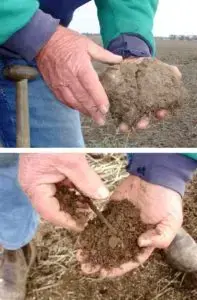
Top: Poor structure of overworked, low organic matter soil.
Below: Soil from the same area, now friable after several years of treatment.
“While we were successfully growing high yielding crops, with high inputs of fertiliser, it seemed that pathogens were an increasing problem. Lucerne flea attacking wheat crops at the 2 to 3 leaf stage became more common, and barley yellow dwarf virus (BYDV) also prevalent. LawrieCo suggested trying the nutri-blend product [now called ‘biologic blend’]. This dramatically changed the chemical analysis of our soils.”
Previous soil tests on Briandra had shown high levels of iron and magnesium, resulting in tie up of nutrients and poor soil structure. After adding the biologic blend, the Wilsons found that the phosphate available for plant uptake, measured through Olson P levels, had increased dramatically. “Pasture paddocks where Olson P had stabilised in the 12-15 range despite annual dressings of 20+ P increased to 19 with the addition of only 10 P in the form of soft rock phosphate, together with 5kg a hectare of boron humates”, Brian explains.
Calcium levels had also increased. This improved the calcium to magnesium ratios, moving it towards a desirable 5:1, from a previous 1.5:1, thus improving the availability of phosphorus, potassium, sulphur and other nutrients. This compared to previous conventional practices of applying up to eight tonnes per hectare of lime, and correcting pH to around 6, which had not improved calcium levels.
Soil structure, already improved by minimising waterlogging, changed from light grey clay, to a reddish brown loam. It was less sticky and had increased infiltration rates.
Brian notes, “The results of the biological soil improvement program trialled over small areas initially, then across the whole farm have been very rewarding. Without the improvements we have made in improving the soil health and fertility over the long term, our soils would continue to be waterlogged, anaerobic, hard setting, sodic and acidic soils”.
The Wilsons are proud to note, “We have shared the lessons we have learnt at Briandra. Over many years of serving on local and regional bodies we have been able to influence the focus of several groups on soil health. In 2012 soil has been listed in the top six assets of the regional catchment strategy”.
Production
PRODUCTION HIGHLIGHTS
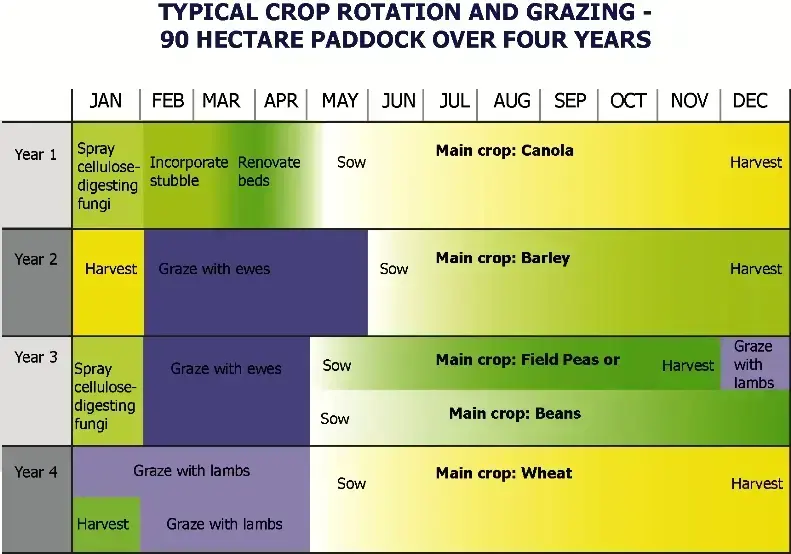
Without the improvements we have made in improving the soil health and fertility over the long term, our soils would continue to be waterlogged, anaerobic, hard setting, sodic and acidic…
Crop rotations over four years follow the sequence of canola, barley, pulse, wheat, as shown above. The pulse is either broad beans or field peas, which provide valuable stubbles, giving high protein supplements to lambs (weaner sheep) and ewes. Brian and Sandra have found that an obvious benefit is weight gain, with lambs reaching 50kg or more live weight by joining at 19 months, with conception rates in hoggets comparable to the older ewes as well; usually 90% in one cycle.
Crop production has remained about the same level as before biological inputs were applied on Briandra. The Wilsons spend around the same amount on fertiliser inputs but are finding that the crops appear greener and more robust. Urea applications have been reduced to about 40% of what they were previously.
Brian points out that recent extreme years of 2006 and 2010, when growing season rainfall was 220mm and 714mm respectively, have made it difficult to assess how much production has been influenced by management change, and how much by weather influences. He does note however, “Suffice to say, the best performed paddocks on those extreme years, have been those where the most biology has been added”.
In 2006 barley yielded 6t/ha compared with an average 4t/ha over the rest of farm. In 2010 the beans yielded 4t/ha without any fungicide applications
It would appear that the immune system of the crops and pasture plants have been enhanced as lower levels of pathogenic attack have been experienced. The need for both insecticide and fungicide use have been dramatically reduced, mostly confined to seed dressings. This has made integrated pest management strategies easier to implement, and beneficial insects are now the Wilson’s main control measure. While production assessments are ongoing, Brian and Sandra report that, generally, cash profits are about the same as they were after the drainage was installed and before the biological amendments were applied. However, they are confident that long term outcomes are better.
Most profits are reinvested in improving the farm. Brian notes, “My business model has the philosophy to use ten per cent of farm gross income in experimentation, starting over small areas, and the encouraging results are expanded, and may develop into standard practice. Any failures, and there have been many, are discarded”.
He advises, “Be prepared to try new methods on your own farm. Use on small scale first. Don’t be afraid to ask questions. Learn from others. Join farm groups”.
The Wilsons are content with what they have achieved on their property and in their region in relation to soil health. “We have personal satisfaction that the soils on the property are much healthier now than we first arrived. We have passed the lessons we have learned on to the wider community and region through our involvement in regional NRM bodies.”
“We now observe a gradual awareness and adoption of innovative solutions for solving seemingly intractable management problems such as waterlogging and pugging on our region’s soils.”
No doubt, the establishment of Southern Farming Systems as an organisation providing farmers in high rainfall areas with ‘real world research and information’ has provided the framework for these innovations and their adoption.




